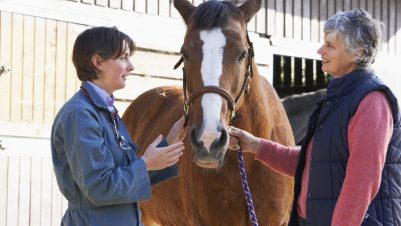Exposure to Borrelia burgdorferi is very common in horses living within a Borrelia endemic area, such as the UK. The resultant disease (Lyme disease), on the other hand, is not clearly understood, nor is the exact seroprevalence in the UK.
Lyme disease is caused by the motile spirochaete Borrelia burgdorferi, although multiple other genospecies exist that could also lead to clinical disease. The spirochaete is transmitted by the Ixodes tick, with Ixodes ricinus being endemic to the majority of the UK. The spirochaete rapidly dies outside of the host (tick or horse) and therefore exposure to a tick bite is essential. The spirochaete is transferred from the intestine of the tick to the animal during a blood meal and it is thought that several hours of attachment are required to allow transmission.
In the human population, clinical signs can include arthritis, carditis, cutaneous pseudolymphoma, malaise and fatigue, although the list of clinical signs is ever expanding. In horses, Koch’s postulates were fulfilled in one study with the organism being cultured from the skin, connective tissue, muscles and near synovial membranes nine months after infection, but none of those horses showed overt clinical signs (Chang et al., 1999; Chang et al., 2000; Chang et al., 2005). A recent consensus statement released by the American College of Veterinary Internal Medicine discussed the controversial nature of Lyme disease and the lack of exact clinical signs (Divers et al., 2018).
Within the UK, testing is mostly limited to the C6 peptide ELISA, which confirms antibody production and thus exposure, but it does not confirm current infection. Liphook Equine Hospital Laboratory offers a polymerase chain reaction that can confirm active infection on suitable samples including synovial membrane, synovial fluid, CSF and serum. A multiplex assay offered by Cornell University can distinguish the various stages of the immune response and therefore indicate if the horse is actively infected or has had a past exposure.
In one experiment by Chang and colleagues where horses were experimentally infected, the C6 titres became negative following antibiotic treatment after four months. This negative serological status correlated with post-mortem confirmation of elimination of the organism. Therefore, it is possible that horses with persistent C6 titres may be chronically infected, could have repeated exposure or have a continued immune response in the absence of disease.
Clinical signs
Clinically, the most documented clinical signs include neuroborreliosis, uveitis and pseudolymphoma at the site of tick attachment. In neuroborreliosis cases, clinical signs can include atrophy of spinous muscles, laryngeal dysfunction, dysphagia, facial paresis, spinal cord ataxia and behavioural changes. In these cases, pyrexia was inconsistent and the neurological signs ranged from 2 to 730 days prior to death (Johnstone et al., 2016). Uveitis has been reported as mostly anterior chamber abnormalities and the normal range of signs associated with uveitis.
Cutaneous lymphoma has been documented in a number of horses with dermal nodular lesions that occurred at the site of tick attachment; Borrelia were confirmed by PCR on the affected tissue. Vaguer clinical signs are frequently attributed to Lyme disease, including stiffness, shifting leg or intermittent lameness, behavioural changes, hyperaesthesia and muscle wasting. Due to the difficulty in diagnosis, these clinical signs have not been definitively linked to B. burgdorferi infection.
Concurrent Anaplasma and Lyme disease infections have been reported so it is advisable to test for Anaplasma if tick exposure is documented.

As multiple hours are needed to transmit the spirochaete from the tick into the horse, prompt removal of ticks should reduce the risk of infection
Treatment
Treatment is a contentious subject considering the poor understanding of treatment in the human field alongside the difficulty in diagnosis in equine patients. For early human infections, oral administration of doxycycline, amoxicillin or cefuroxime over two weeks is recommended with longer treatment having little further effect. If neurological signs are seen, treatment with parenteral ceftriaxone, cefotaxime or penicillin G is undertaken for two weeks. Finally, in chronic cases manifesting with arthritis, treatment is often extended to four weeks.
Oral doxycycline is generally considered efficacious in humans but in horses the bioavailability is highly variable and might lead to treatment failure. Following a study where treatment was started three months following experimental infection, the best rate of clearance was seen with one month of IV tetracycline administration compared to oral doxycycline or intramuscular ceftiofur (Chang et al.,1999). Anecdotally, there appears to be a good response to oral doxycycline. The options for treatment are indicated in Table 1.
When planning a treatment protocol, a considered approach to antibiotic stewardship should be undertaken. As such, the likes of ceftiofur, metronidazole and other antibiotics should be withheld until absolutely required and should not be used as a first line treatment in these cases. The use of antibiotics in non-clinical horses with elevated titres should be avoided and only horses with clinical signs and a positive titre should be treated.
Additional medications can be used in some cases, with NSAIDs being a mainstay in those patients that are painful or are neurologically affected – particularly for those showing lameness or joint effusion. Dexamethasone treatment in humans has been associated with both positive and negative outcomes, so should only be considered in those cases with uveitis or acute, severe neuroborreliosis (Johnstone et al., 2016).
Tick control is essential in areas with a known problem and should be the mainstay of prevention. This could include topical treatments, reduction in long grasses/ground cover and strict monitoring of horses for ticks. As multiple hours are needed to transmit the spirochaete from the tick into the horse, prompt removal of ticks should reduce the risk of infection.
The prognosis is as hard to objectively assess as the clinical signs in horses. In humans, a 90 percent cure rate is achieved in those patients treated early with antibiotics with the remainder showing non-specific ongoing clinical signs. The only documented treatment outcome in horses is for neuroborreliosis cases where the prognosis is poor with only a single successful outcome documented.
Lyme disease is a poorly documented and understood disease. The exact clinical signs are not known except in those cases of neuroborreliosis and uveitis and therefore the use of antibiotics should be carefully considered in cases where the suspicion of disease is low.











